I never noticed before that maple seeds come in twos and look like beautiful veined wings ...


I've always just noticed them on the ground, all dried up and they look like this ...

They fall like helicopters looking for a landing pad. Which is just what they were "designed" to do.
Did you know that ...
Maple seeds show great design to fulfill the needs for maple trees to reproduce. A maple tree can spread shade over a large area. In order for it to reproduce, its seeds have to get far enough away from the parent tree that the young trees will not be shaded by the parent. This means that as the seed falls off the tree it has to stay airborne long enough that it will travel for a significant distance. The very complex design of the maple seed allows it to begin its helicopter autorotation almost the instant it is released from the tree.
Balance a maple seed on the tip of your finger. Notice that the mass is concentrated in the actual seed and the wing sticks out a great distance from the center of gravity. You will also notice that the wing is narrow near the seed and broadens gradually until you get near the end where it tapers. As the maple seed spins, the speed of the air over its surface gets greater as you move out from the seed, so having the blade wider farther out provides a huge increase in lift. This design puts the center of lift at the approximate center of the spinning seed structure. If the end of the wing had a blunt surface, small vortexes of air would swirl around the tip and produce drag slowing the rotation. By tapering the wing at the tip, drag is reduced.
If you look carefully at the wings, you will see that they have veins in them. The veins are concentrated on the leading edge of the wing – the part that cuts into the air. This rough texture produces beneficial turbulence and the weight of the veins improves the angle of attack of the wing. Dimples on golf balls serve a similar purpose of producing beneficial turbulence. Bird wings are also designed with the shaft on the leading edge and the feathers on the back.
Maple seeds do not fall off the tree until the wings are quite dry. This has two advantages. For one thing it makes them lighter so that they will fly farther. It also makes the wing more brittle so that once they land the wing material may break away from the seed. Although the wing is important to get the seed to its destination, once the seed has landed the wing has served most of its purpose. When the seed lands between blades of grass, the wing may help the seed to stand vertically enabling it to more easily imbed into the ground.
Many would suggest that natural selection is the only agent here – that any other wing design would be less successful and thus would be eliminated from the population. The fact is that natural selection cannot add anything to the design. It can only take away non-beneficial properties. This is an example of another Dandy Design. Where did the design come from? It’s the intelligence behind the design and behind the forces that keep it operative that speak of God’s wisdom and creative action.




















1 comment:
I think of that so often, that our God is such an awesome Creator. And because He creates is the reason that we can create (although not out of nothing), because we are made in His image. Love the post. And I also posted about maple seeds this week! I guess we were both impressed with the beauty and design. :-)
Post a Comment